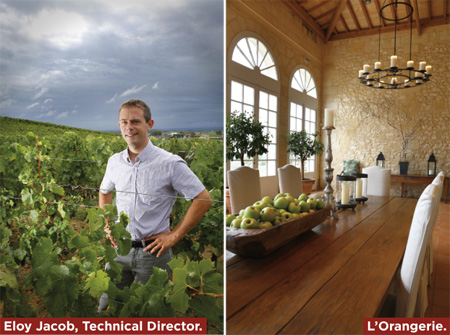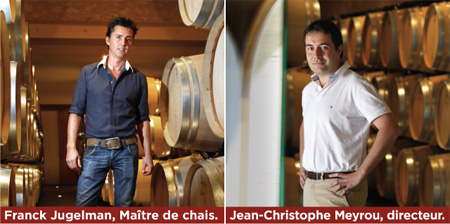Winegrowers’ Portraits Saint-Émilion
Château Fonplégade
Precision workmanship to achieve
an overt, realistic ambition
Behind the History with a capital H there is another, more discreet, that gives bearing and real-life experience to an estate. The southern slopes of the hills around the village of Saint-Émilion, the growing area of Château Fonplégade, have been a landmark since the time of the Romans, and then of the pilgrims, who came to quench their thirst at the fountain of abundance from which the estate takes its name.

 The illustrious négociant Jean-Pierre Beylot was the first to understand the unique potential of the property. He gave it its current dimensions and had the Château built in 1852, announcing the beginning of the first period of prosperity for Fonplégade, whose reputation improved further with the subsequent owners, who were none other than the step brother and sister of a certain Napoleon III.
The illustrious négociant Jean-Pierre Beylot was the first to understand the unique potential of the property. He gave it its current dimensions and had the Château built in 1852, announcing the beginning of the first period of prosperity for Fonplégade, whose reputation improved further with the subsequent owners, who were none other than the step brother and sister of a certain Napoleon III.
Awarded the gold medal at the 1867 Paris Universal exhibition, the cru continued its ascension and was promoted to Premier Grand Cru, a distinction it conserved until the mid 1940s. It was not until the first classification of Saint-Émilion wines, in 1955, that it became a prestigious Grand Cru Classé. The vineyard, surrounded by Premiers Grands Crus, changed hands between several Saint-Émilion families, unaware of its real potential.
After years in limbo, a new golden age arrived: in 2004, Stephen and Denise Adams, an American couple with exceptional academic and business credentials, turned their attention to its fate, having previously acquired Pomerol's Château L’Enclos. In 2006, they decided out of conviction to farm the vineyard organically: a challenge that paid off when they obtained certification for the entire 18.5 hectares – 17.5 of which are in production - and especially when they gained the favour of distinguished tasters and journalists the world over.
After an experience in the vineyards of the late Catherine Péré-Vergé in Pomerol, Jean-Christophe Meyrou, the director of the estate, arrived in 2010 to orchestrate the ascension of the Château to the historic title of Premier Grand Cru Classé in the next classification in 2022. An overt ambition which is consistent with an increasingly high-precision approach to the 92% Merlot, completed by the Cabernet-Francs planted in the top part of the property.


The restructuring of the vineyard and its conversion to organic methods have allowed Jean-Christophe Meyrou and his team to work more in the winery. 75% of the harvest is fermented in oak casks with punching of the cap and pumping over, then the malolactic fermentation and ageing takes place in barrels. Certain batches undergo micro-fermentation in 500-litre Burgundy barrels “with 10 to 15% of red grape stalks when barrelled, to add velvety smoothness, appeal and freshness to the wine”, the director remarks.
Only 8% of the fine wine is aged in “pods”, to preserve the mineral character and the purity of the fruit. The composition of the barrel stock has been changed, by reducing the number of new barrels to 20% of the total and increasing their quality; fewer but better, with slower heating cycles more closely adapted to suit the raw ingredients.
Vintage after vintage, tests, observations and remarks have gradually restored the image of a cru that remained in the shadows for too long, so that it can regain its former glory and take the place that the prestigious terroir deserves.
A superb boutique that has 7,000 visitors a year, a Wine Club with 700 VIP members, whose numbers are steadily increasing, regained control of quality distribution of the wines, the latest vintages praised by the trade - are so many signs that the coveted classification status could well become a reality…
Histoire à suivre.
Florence Varaine
Château Fontplégade
1, Fonplégade
33330 Saint-Émilion - France
Tél.: +33 (0) 5 57 74 43 11
www.fonplegade.com

 The illustrious négociant Jean-Pierre Beylot was the first to understand the unique potential of the property. He gave it its current dimensions and had the Château built in 1852, announcing the beginning of the first period of prosperity for Fonplégade, whose reputation improved further with the subsequent owners, who were none other than the step brother and sister of a certain Napoleon III.
The illustrious négociant Jean-Pierre Beylot was the first to understand the unique potential of the property. He gave it its current dimensions and had the Château built in 1852, announcing the beginning of the first period of prosperity for Fonplégade, whose reputation improved further with the subsequent owners, who were none other than the step brother and sister of a certain Napoleon III. 
